For those who do not know, spring time is the most chaotic time of the year for those who work with bonsai. Especially on a higher level and I’m talking about trees that have been shown at Nationals or are destined to go one day in the future. When I was presented with the opportunity to help Dawn Koetting work on some of her award winning bonsai I could not say no.
There is far too many technical practices for this time of year to cover in one blog post but I will do my best. Thing is, in Louisiana our window for spring work is narrow and the temperatures are all over the place. One night it is 30°F followed by 75°F during the next day. Random light to hard freezes can happen any night January to March. Some years there are multiple freezing nights and some years there is only one single night of temperatures below 40°F. The so called winter season here is the most unpredictable thing I can think of. So we have to juggle stressful jobs with our trees like repotting, thinning, thread grafting, and carving into live wood with the thought that a bomb of a hard freeze could happen randomly. So we have cold frames always at the ready for our stressed trees!
I snapped as many photos as I could throughout the work day. We started at 7:30 am each morning and the full day I had the liberty staying all day to work we worked 12 hours on bonsai. Dawn has a pretty demanding collection at several different levels of training.
Some trees are just months away from show ready while others need lengthy procedures to work them towards a showable stage in their existence. Funny thing is that not all bonsai look show ready all of the time. The picture we see of these amazing trees in high quality photo-ops is just the best that particular tree has looked all year. As Dawn has told me, bonsai go in cycles of development and we have to know how to plan their lead up to being ready for display. That’s why there are “grow pots”, sometimes called “training pots”, and there are “show pots”. Bonsai only go into those fancy, nice and shallow containers for a short period of time. In some cases in Japan bonsai that go into shows are planted in their special containers for just a few days and then are planted back into their grow pots.
Sometimes being beautiful is being in a highly stressful situation for most bonsai. In the most skillful hands, some trees are thinned, wired, repotted, and then transported miles away to be put on display. It’s all a balancing act of know just know how much strength has been built up in each tree and how much tedious work can be preformed each season. Bonsai need years off from this type of work or they will literally be worked to death.
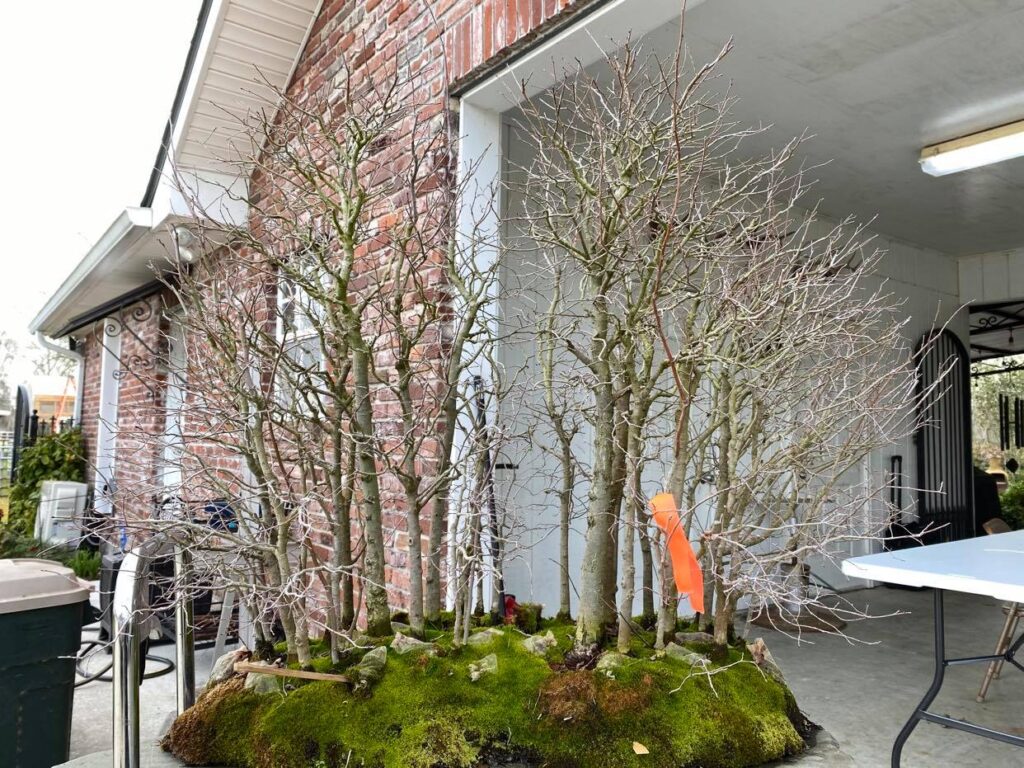
I did the best I could with the space provided for photos of these trees.
Pictured above is Dawn’s American elm forest on a Joe Day carved stone slab. All of the elms were collected in Mississippi by Dana Quattlebuam. Dawn has been working with this forest for right over 10 years now and it is one of her several trees that have been to Nationals. They have been allowed to grow freely for the past 4 years since their trip up to Rochester, NY. As noted by Dana, this forest has only gotten better with time. The lovely side branching you are seeing is a new development.
I had the honors of assisting Dawn in the repot of this amazing forest planting. It took roughly 3 hours to work down the soil on the top of the root mass back to the surface roots, nebari, of each elm. It is in best practice to work from the top down when repotting trees with old root structures such as these trees have.
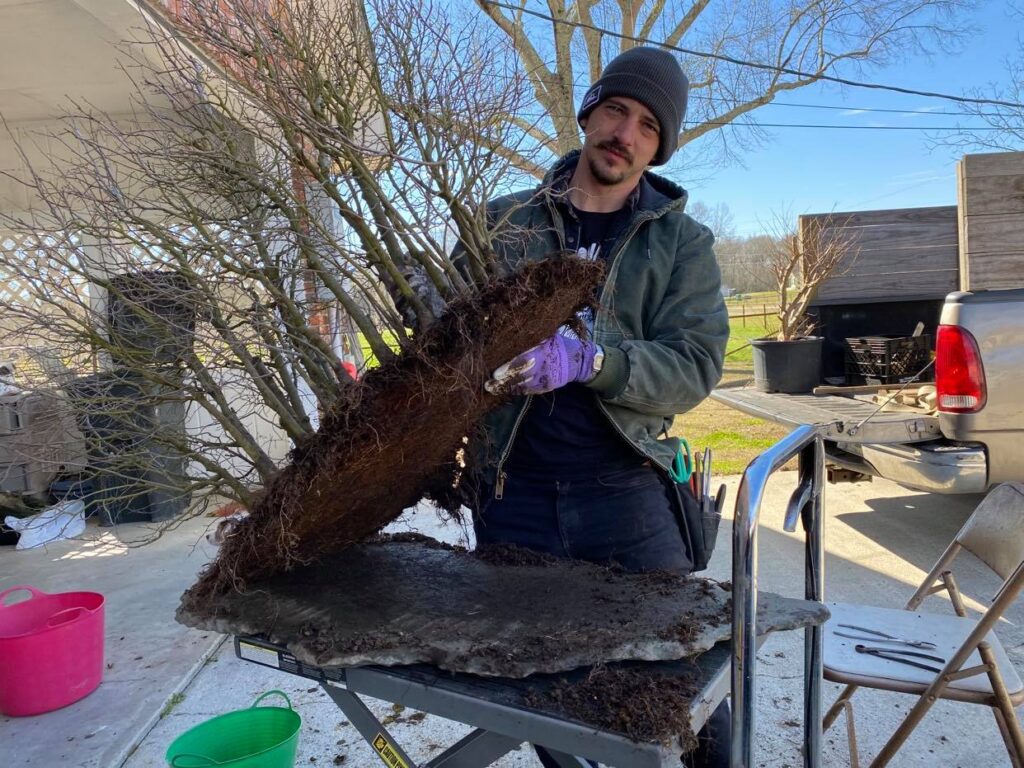
Me lifting the root mass away from the slab. The entire forest is nicely established and the whole thing can picked up without the fear of trees falling out of the composition. Well fused root systems of multiple trees look like this. They get to a point of being so entwined with each other that they basically become one. Repotting forest plantings can be similar to a singular tree planting. Of course rearranging trees or adding/taking away trees can make these type of procedures much more complicated.

Dawn hosing down the planting getting it ready for placing it back on the slab.
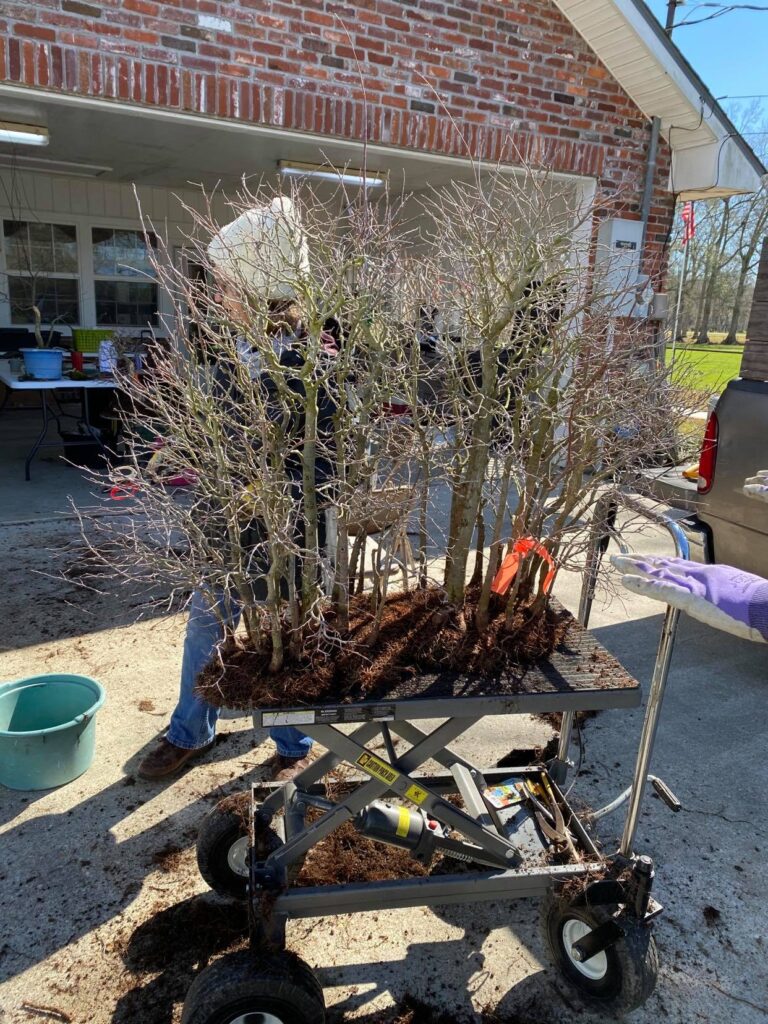
The planting after top and bottom root thinning has been done. The trees are ready but what about the slab you would say. Well the slab actually does not have any drain holes or tie down points. You can see what I’m talking about in the picture of me lifting the forest away from the slab. The only thing holding them to the slab is a well executed mucking technique. We built up a solid muck wall for the first layer of soil to rest inside of and the trees were placed on top.
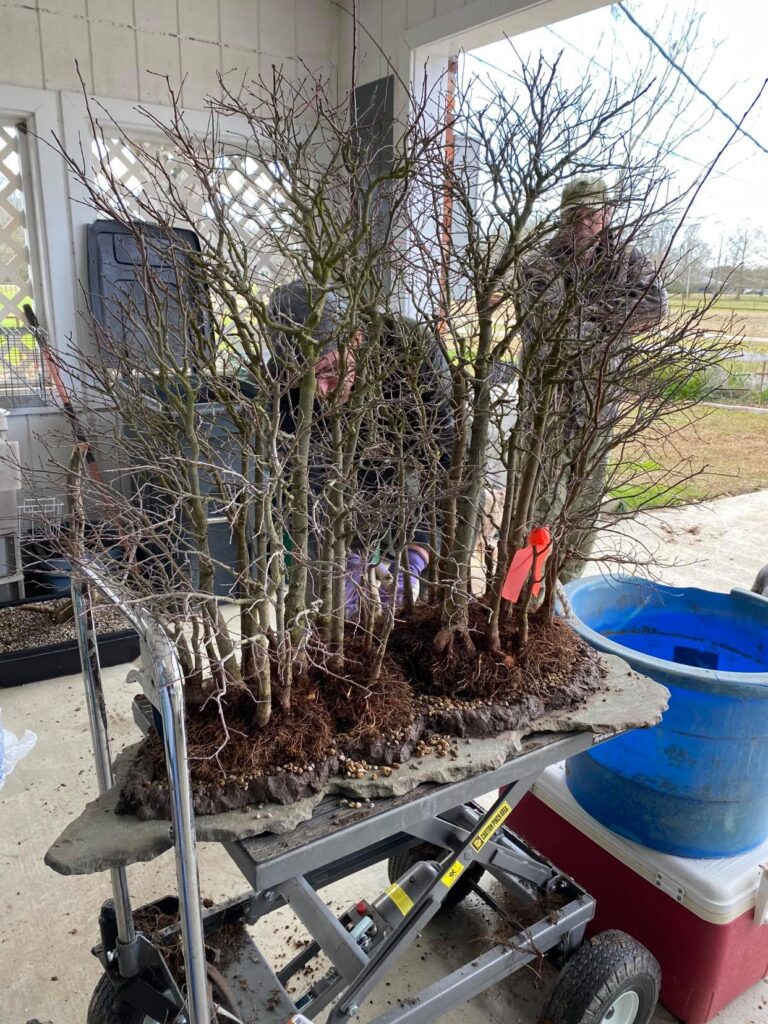
That’s Donald, Dawn’s husband, watching me tuck in the trees into the new wall of muck.
For those who are not familiar with “muck”, it is a bend of clay and long stranded sphagnum moss. There are more components then just clay and moss but they other ingredients are based of region and environment. The muck is very freeform and should feel natural as it is applied to the slab. I will be doing a whole blog post on re-building a bald cypress slab planting within the month so don’t you worry!
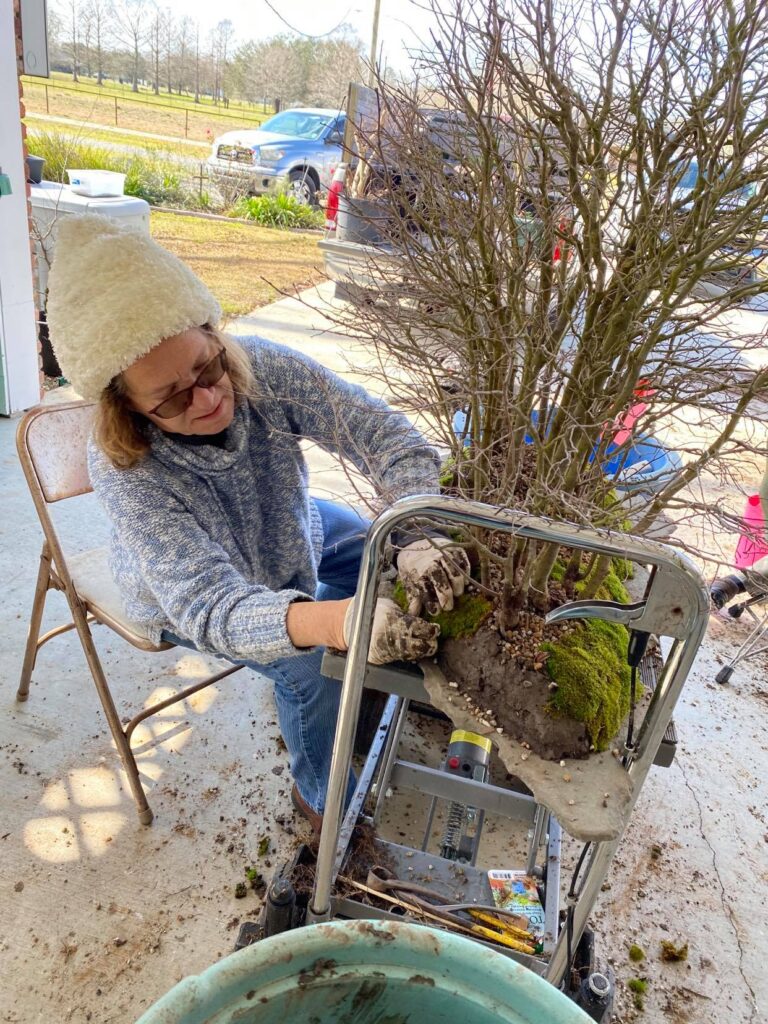
Dawn remossing the planting. This carpet moss is vital to keeping the muck wall intact also while helping retain the moister in the soil below. Building up the muck wall is basically like building your own container from scratch. The muck encapsulates the planting much like the walls of a ceramic container but the maintenance is much higher. If you have trouble keeping your trees watered, just imagine the added stress of not being able to let this planting dry out. Plantings of this caliber need to be always moist and never allowed to dry out because the entire system can start to collapse very quickly.
This is how Dawn deals with it, hand watering. Her and her husband routinely hand water throughout the day and never miss a beat. To some this may seem a little extreme but in reality this is not as extreme as you might think. Some bonsai practitioners in Japan work 7 days a week every day of the year, sun up to sun down. Highly tuned bonsai collections take true commitment to keep in check and Dawn works at that level.
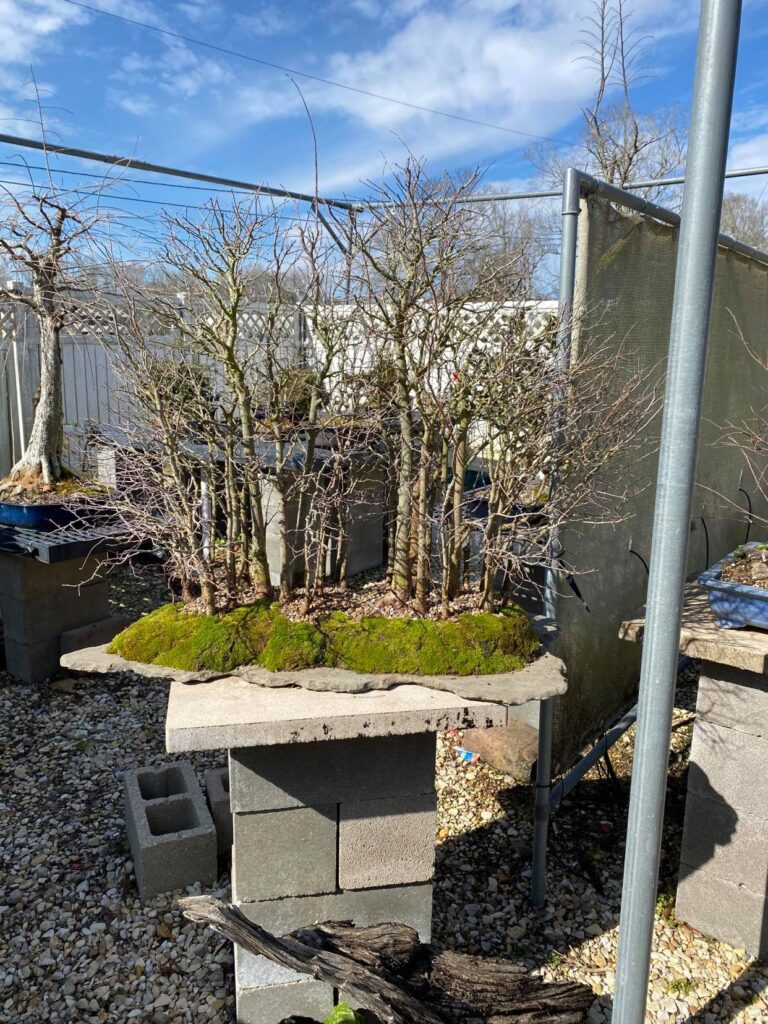
The American elm planting completed and placed back in the garden. There will be those out there that will yell “You can’t put freshly repotted bonsai back into the full sun!” but in the case that our winter is still technically happening it is actually very mild outdoors. Even in direct sunlight the temperature is no more then 70°F. Also, Dawn will more then likely be watering this planting 2-3 times each day until bud brake in the spring time.
Side note: Dawn messaged me about how she could not sleep over the fact that something did not feel right about the repotting of the elm forest. She took the forest back into her work area to further refine the root mass for further reassurance. That’s how dedicated she truly is to her collection.
Also to consider how much time it took to just repot this one planting: we started work on it at 8 am and finished after lunch. It took roughly 4.5 hours to make this happen. Now consider having nearly 100 bonsai at this level or building up to it.
